Science
(www.olympiadsuccess.com)
Chapter 14: Electric Current and its Effects
Class VII
Multiple Choice Questions
Question 1
When an electric current flows through a copper wire AB as shown in Figure14.1, the wire
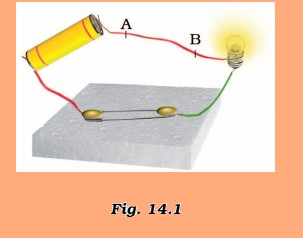
(a) deflects a magnetic needle placed near it.
(b) becomes red hot.
(c) gives electric shock.
(d) behaves like a fuse.
Answer 1
(a)
Question 2
Choose the statement which is not correct in the case of an electric fuse.
(a) Fuses are inserted in electric circuits of all buildings.
(b) There is a maximum limit on the current which can safely flow through the electric circuits.
(c) There is a minimum limit on the current which can safely flow in the electric circuits.
(d) If a proper fuse is inserted in a circuit it will blow off if current exceeds the safe limit.
Answer 2
(c)
Question 3
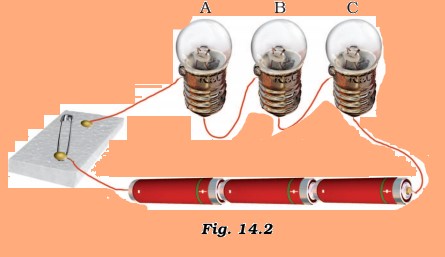
Three bulbs A, B, C are connected in a circuit as shown in Figure 14.2. When the switch is ‘ON’
(a) bulb C will glow first.
(b) bulb B and C will glow simulaneously and bulb A will glow after some time.
(c) all the bulbs A,B and C will glow at the same time.
(d) the bulbs will glow in the order A, B and C.
Fig. 14.2
Answer 3
(c)
Question 4
When a switch is in OFF position,
(i) circuit starting from the positive terminal of the cell stops at the switch.
(ii) circuit is open.
(iii) no current flows through it.
(iv) current flows after some time.
Choose the combination of correct answer from the following.
(a) all are correct
(b) (ii) and (iii) are correct
(c) only (iv) is correct
(d) only (i) and (ii) are correct
Answer 4
(b)
Question 5
Which of the following precautions need not be taken while using electric gadgets/appliances/circuit?
(a) We should never touch a lighted electric bulb connected to the mains.
(b) We should never experiment with the electric supply from the mains or a generator or an inverter.
(c) We should never use just any wire or strip of metal in place of a fuse.
(d) We should never turn the switch in ON position.
Answer 5
(d)
Very Short Answer Questions
Question 6
Which property of a conducting wire is utilised in making electric fuse?
Answer 6
Low melting point.
Question 7
Name the device used these days in place of electric fuses in electrical circuits.
Answer 7
Miniature Circuit Breaker (MCB).
Question 8
Fill in the blanks:
(i) Our body is a ________________ of electricity.
(ii) An electric cell produces electricity from the __________ ___________ in it.
(iii) In an electric circuit a fuse is a _________ _______ to prevent possible fire.
(iv) A combination of two or more cells is called a _________.
Answer 8
(i) conductor (ii) chemicals stored (iii) safety device (iv) battery
Question 9
Unscramble the following words:
(i) TBTAYER
(ii) SFEU
(iii) HTRCO
(iv) HICWTS
Answer 9
(i) Battery (ii) Fuse (iii) Torch (iv) Switch
Question 10
Paheli does not have a night lamp in her room. She covered the bulb of her room with a towel in the night to get dim light. Has she taken the right step? Give one reason to justify your answer.
Answer 10
No. The towel may burn due to the heat produced by the bulb. Besides, it will also result in wastage of electric energy.
Question 11
Why are compact fluorescent lamps (CFLs) preferred over electric bulbs?
Answer 11
CFLs do not waste electricity as heat.
Question 12
Why is an electric fuse required in all electrical appliances?
Answer 12
To check the excessive flow of electric current.
Short Answer Questions
Question 13
Can we use the same fuse in a geyser and a television set? Explain.
Answer 13
No, a geyser and a television set require different amount of current. Therefore the fuse used in these will be of different ratings.
Question 14
Name two electric devices for each where (i) heating effect of current is used and (ii) magnetic effect of current is used.
Answer 14
Heating effect – Geyser, room heater. Magnetic effect – Electric bell, Cranes to lift magnetic material.
Question 15
Why do we cover plug pin holes which are within the reach of children with cellotape or a plastic cover when not in use?
Answer 15
The child may put his/her fingers into the socket and he/she may get an electric shock which could be fatal.
Question 16
Boojho made an electromagnet by winding 50 turns of wire over an iron screw. Paheli also made an electromagnet by winding 100 turns over a similar iron screw. Which electro magnet will attract more pins? Give reason.
Answer 16
Paheli’s electomagnet will attract more pins as it has more number of turns of wire on it and thus a stronger electromagnet.
Long Answer Questions
Question 17
Your teacher has shown you the following activity.
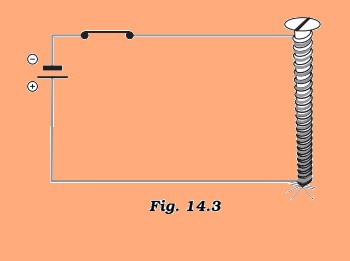
Activity: Teacher has wound a long insulated piece of wire around an iron nail in the form of a coil. Free ends of the wire are connected to a cell through a switch as shown in the Figure
14.3. The current is switched on and some pins are placed near the ends of the nail.
Write down any three questions that come to your mind about this activity.
Answer 17
Some of the questions can be
(i) Why does the nail attract the pins?
(ii) What will happen if we connect more cells in the circuit?
(iii) What will happen if we use some other material like a straw in place of the nail?
(iv) What will happen if we wrap the wire on the nail more tightly?
or
Any other appropriate question.
Question 18
Paheli took a wire of length 10 cm. Boojho took a wire of 5 cm of the same material and thickness. Both of them connected the wires as shown in the circuit given in Figure 14.4. The current flowing in both the circuits is the same.
(i) Will the heat produced in both the cases be equal? Explain.
(ii) Will the heat produced be the same if the wires taken by them are of equal lengths but of different thickness? Explain.
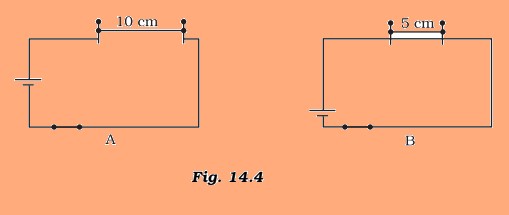
Answer 18
(i) No, the amount of heat produced in both the cases will not be equal. Amount of heat produced in a wire depends upon the length of the wire.
(ii) No, the amount heat produced in the wire depends upon the thickness of the wire.
Question 19
How does the magnetic effect of electric current help in the working of an electric bell? Explain with the help of a diagram.
Answer 19
Hint: Working of an electric bell.
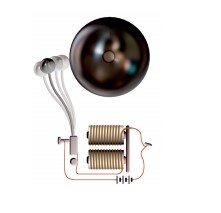
Question 20
Draw the symbols of the following circuit components.
(i) electric cell
(ii) switch in off position
(iii) electric bulb
(iv) battery
Answer 20
(i)
(ii)
(iii)
(iv)
Yearlong program for Olympiads preparation & to build necessary skills for future.
Explore More
Time to mark your calendar with the upcoming Olympiads exam schedule.
Explore More
Take your Olympiad preparation to next-level by taking LIVE Classes.
Explore More
Assess your performance by taking topic-wise and full length mock tests.
Explore More
Online tuitions for international compeitions like SASMO, SEAMO, etc for Grades 1-11.
Explore More